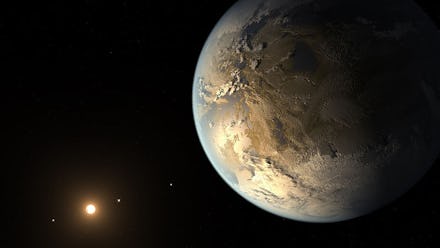NASA Discovers the Best Evidence Yet That Life Exists Outside Our Solar System

Using the Kepler space telescope, NASA astronomers have found the first planet that they believe to be made of rock, roughly equivalent in size to Earth and potentially capable of supporting life.
The planet, Kepler-186f, orbits the star Kepler-186 some 490 light years away in the constellation Cygnus. It has a diameter of 8,700 miles, making it larger than Earth, and its orbit lies within the "Goldilocks zone" where temperatures could allow for liquid water to flow on its surface. Kepler-186f likely even boasts similar gravity. It's the first such planet to ever be discovered outside of our solar system.
"It's Earth-size," Elisa V. Quintana of the SETI Institute and NASA's Ames Research Center told the New York Times. "It's in the habitable zone. So we now know these planets do exist."
The Bay Area Environmental Research Institute's Thomas S. Barclay says "It's a progression. ... This is a very, very exciting milestone discovery. It has a much higher probability of being habitable. This planet really reminds us of Earth."
Image Credit: NASA
Kepler-186f is on the outer edge of its star's habitable zone, meaning it could be cool enough that any liquid water on its surface would freeze. But it orbits a dwarf star, which is among the oldest stars in the universe, meaning any life will have had billions of years to develop. And since dwarf stars are plentiful (more than 70% of the hundreds of billions of known stars are main-sequence M-dwarfs), the discovery of Kepler-186f implies there may be many more such planets scattered throughout known space. Furthermore, being at the edge of the habitable zone may protect Kepler-186f from the harmful solar flares and damaging radiation such dwarf stars emit at higher rates than G-type stars like our own sun.
The Kepler telescope launched in 2009, but precision gyroscopic wheels on the craft failed in 2013, ending its life as a planet-hunter. But it discovered thousands of candidates during its three-year operational history. The remaining Kepler data to be analyzed includes more than 2,800 planet candidates, meaning that many more Earth-like bodies could remain to be discovered.